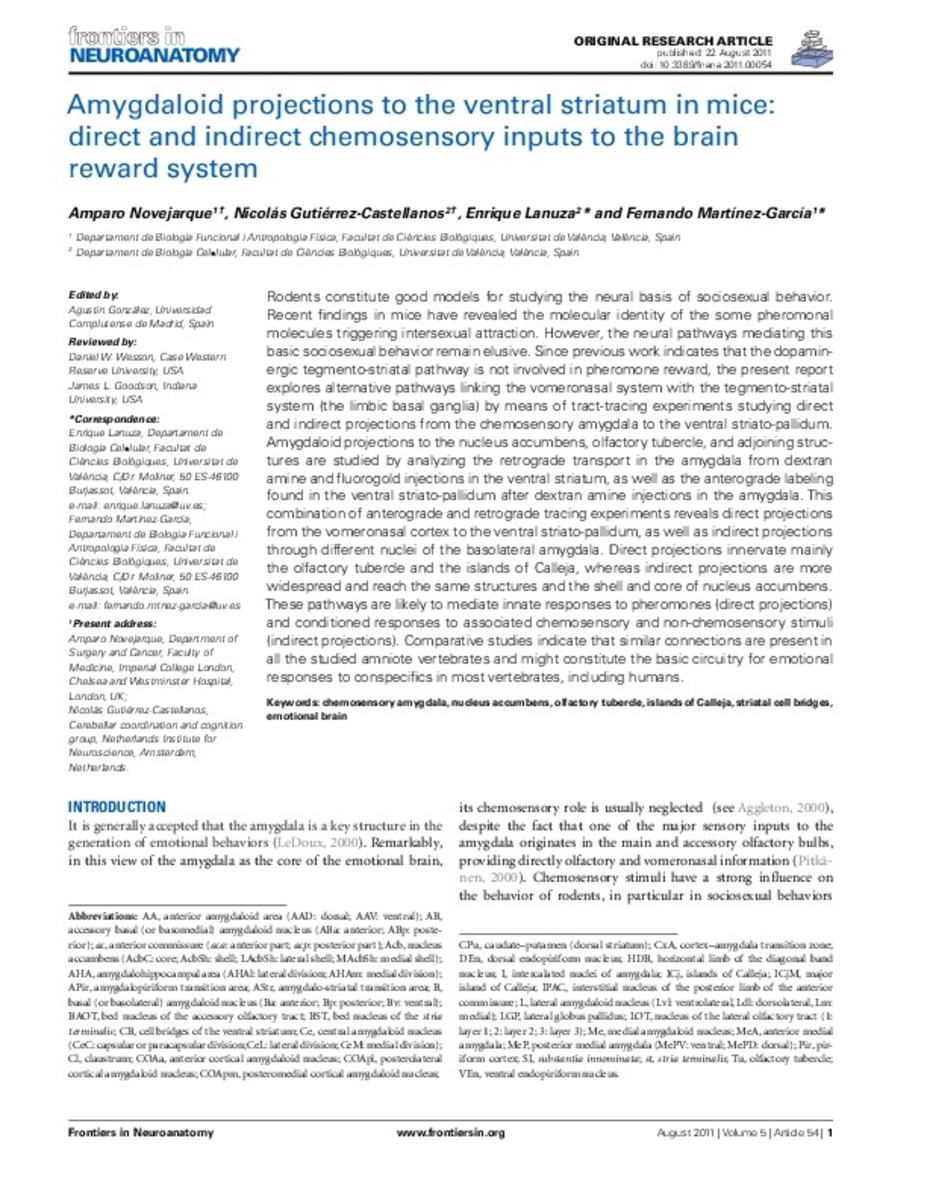Mostrar el registro sencillo del ítem
Amygdaloid projections to the ventral striatum in mice: direct and indirect chemosensory inputs to the brain reward system
| dc.contributor.author | Novejarque, Amparo | |
| dc.contributor.author | Gutiérrez-Castellanos, Nicolás | |
| dc.contributor.author | Lanuza, Enrique | |
| dc.contributor.author | Martinez-Garcia, Fernando | |
| dc.date.accessioned | 2015-05-21T11:12:54Z | |
| dc.date.available | 2015-05-21T11:12:54Z | |
| dc.date.issued | 2011-08-22 | |
| dc.identifier.issn | 1662-5129 | |
| dc.identifier.uri | http://hdl.handle.net/10234/121445 | |
| dc.description.abstract | Rodents constitute good models for studying the neural basis of sociosexual behavior. Recent findings in mice have revealed the molecular identity of the some pheromonal molecules triggering intersexual attraction. However, the neural pathways mediating this basic sociosexual behavior remain elusive. Since previous work indicates that the dopaminergic tegmento-striatal pathway is not involved in pheromone reward, the present report explores alternative pathways linking the vomeronasal system with the tegmento-striatal system (the limbic basal ganglia) by means of tract-tracing experiments studying direct and indirect projections from the chemosensory amygdala to the ventral striato-pallidum. Amygdaloid projections to the nucleus accumbens, olfactory tubercle, and adjoining structures are studied by analyzing the retrograde transport in the amygdala from dextran amine and fluorogold injections in the ventral striatum, as well as the anterograde labeling found in the ventral striato-pallidum after dextran amine injections in the amygdala. This combination of anterograde and retrograde tracing experiments reveals direct projections from the vomeronasal cortex to the ventral striato-pallidum, as well as indirect projections through different nuclei of the basolateral amygdala. Direct projections innervate mainly the olfactory tubercle and the islands of Calleja, whereas indirect projections are more widespread and reach the same structures and the shell and core of nucleus accumbens. These pathways are likely to mediate innate responses to pheromones (direct projections) and conditioned responses to associated chemosensory and non-chemosensory stimuli (indirect projections). Comparative studies indicate that similar connections are present in all the studied amniote vertebrates and might constitute the basic circuitry for emotional responses to conspecifics in most vertebrates, including humans. | ca_CA |
| dc.format.extent | 20 p. | ca_CA |
| dc.format.mimetype | application/pdf | ca_CA |
| dc.language.iso | eng | ca_CA |
| dc.publisher | Frontiers | ca_CA |
| dc.relation.isPartOf | Frontiers in Neuroanatomy, v. 5, article 54 | ca_CA |
| dc.rights | Copyright: © 2011 Novejarque, Gutiérrez-Castellanos, Lanuza and Martínez-García. This is an open-access article subject to a non-exclusive license between the authors and Frontiers Media SA, which permits use, distribution and reproduction in other forums, provided the original authors and source are credited and other Frontiers conditions are complied with. | ca_CA |
| dc.rights.uri | http://rightsstatements.org/vocab/InC/1.0/ | * |
| dc.subject | chemosensory amygdala | ca_CA |
| dc.subject | nucleus accumbens | ca_CA |
| dc.subject | olfactory tubercle | ca_CA |
| dc.subject | Islands of Calleja | ca_CA |
| dc.subject | striatal cell bridges | ca_CA |
| dc.subject | emotional brain | ca_CA |
| dc.title | Amygdaloid projections to the ventral striatum in mice: direct and indirect chemosensory inputs to the brain reward system | ca_CA |
| dc.type | info:eu-repo/semantics/article | ca_CA |
| dc.identifier.doi | http://dx.doi.org/10.3389/fnana.2011.00054 | |
| dc.rights.accessRights | info:eu-repo/semantics/openAccess | ca_CA |
| dc.relation.publisherVersion | http://journal.frontiersin.org/article/10.3389/fnana.2011.00054/full | ca_CA |
| dc.type.version | info:eu-repo/semantics/publishedVersion |
Ficheros en el ítem
Este ítem aparece en la(s) siguiente(s) colección(ones)
-
MED_Articles [649]
Articles de publicacions periòdiques







